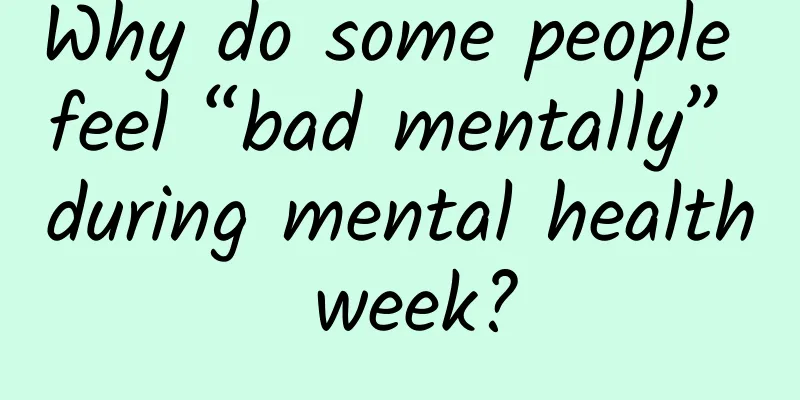Why do some people feel “bad mentally” during mental health week?

|
In today's society, mental and psychological illness has become a major problem. There are a lot of reports and discussions about it in various media. However, according to the latest research, scholars have proposed a "morbidity inflation" hypothesis. Written by Li Changqing October 10th of each year is World Mental Health Day. The purpose of establishing this "festival" is to raise people's awareness of mental health, respond to the challenges of mental and psychological illnesses, and to encourage public health and administrative managers to actively respond to the mental health crisis in the whole society and formulate relevant policies and regulations. At such times, a large number of institutions, non-profit organizations, industry experts, and social media will come out to call on us, telling us how serious the mental health issues in society are now, and that we must reach out and seek help. However, some experts are skeptical about the value of this activity, represented by British psychiatrist Simon Wessely. And behind this school of thought is some evidence provided by new research. Too much attention, more harm than good? Simon Wesley is the former president of the Royal College of Psychiatrists and the first psychiatrist to serve as president of the Royal Medical Society in 200 years. Similar to other countries around the world, the UK also has its own Mental Health Awareness Week, which has been held in May every year since 2001. In an interview with the British Medical Journal (BMJ) in 2017, he said: "Every time Mental Health Week comes, my spirits are not good." In this interview, he believes that the current publicity of mental illness has been a bit excessive. Many people seek medical treatment for normal mental and psychological reactions, which makes the already stretched mental health service resources even more overwhelmed and also affects those patients who really need services. Simon Wesley's view is probably still non-mainstream in the mass media, although there is no lack of support within the profession. With the publication of some recent research results, this view is gradually gaining factual basis. The New York Times reported the results of the two trials in May 2024 and interviewed the lead researchers. One trial was conducted in the UK, called "My Resilience in Adolescence (MYRIAD)". The trial included more than 8,000 teenagers from 85 schools in the UK. According to the size of the school, half of the schools were randomly provided with school-based mental health courses, a total of 10 classes, each 30 to 50 minutes; the other half of the schools were taught as usual without special mental health courses. The results of the trial showed that students in the schools that received the mental health courses not only did not show significant improvement in several major indicators (anxiety, depression), but were worse in several minor indicators (hyperactivity, compulsive behavior, panic attacks). In Australia, a trial involving more than 2,000 students in 37 schools during the same period found similar results: students who participated in mental health courses showed more symptoms of anxiety and depression. Given that such results were unexpected, the lead authors of the two studies, Lucy Foulkes of the University of Cambridge in the UK and Jack Andrews of the University of New South Wales in Australia, published a joint article in New Ideas in Psychology in April 2023, attributing this phenomenon to the prevalence inflation hypothesis. Prevalence inflation hypothesis The prevalence inflation hypothesis holds that the current rise in the incidence of mental illness is partly due to publicity, but this effect has both positive and negative aspects. On the positive side, the campaign has helped some patients who previously should have received medical treatment to recognize their own problems, and by eliminating prejudice and discrimination against mental illness, it has also reduced the resistance of patients to receiving medical treatment. These patients are the ones that the campaign should really win over, and this is why the campaign should continue. The negative impact mainly comes from overinterpretation. Overinterpretation comes from both propaganda and the self. Some propaganda campaigns do not distinguish between normal emotional reactions and real mental illnesses, and encourage people with negative emotions to boldly "come out" and "speak out". Social media sometimes glorifies mental illnesses, making depression look fashionable and cool. Personal overinterpretation often occurs through a process of self-fulfilling prophecy: if a person is labeled with a certain mental illness by themselves and others, they will tend to show more symptoms of this illness. The most common example is anxiety: many people have anxiety, and some anxiety symptoms are normal, such as fear of speaking in public. But if they are labeled with anxiety disorders, some people will accumulate more anxiety symptoms. Simon Wesley mentioned above has another important contribution, which is also related to over-interpretation, about post-traumatic stress disorder (PTSD). He has personally been engaged in the study of military-related mental and psychological disorders for a long time. He found that psychological intervention immediately after a traumatic event is often ineffective and may even increase post-traumatic stress symptoms. His advice is to allow the injured to return to their families and friends as soon as possible, and to intervene only if serious symptoms still exist after a few months. The reason is that those who intervene early are aware of the possible symptoms of post-traumatic stress, which will make the traumatized have "expectations" for stress symptoms and amplify possible symptoms. As mentioned above, the prevalence inflation hypothesis and Wesley's views are not mainstream at least in the mass media. Most people still believe that publicity and education have more benefits than disadvantages, not to mention that some experimental results are positive. The main purpose of Fulks and Andrews' article is to call for more research on this hypothesis and also list many research ideas. What the conclusion may be remains to be seen. Medicalization of social problems Freelance writer Colette Schade asked people on social media for their thoughts on mental health campaigns. Many responded, including one construction worker diagnosed with depression and anxiety: "I hate these campaigns. ... They're using fly swatters to hit flies when they see a mountain of shit behind them." In an article published in The Nation magazine, Shad quoted Rudolf Virshow, the father of modern pathology, and divided epidemics into natural epidemics and artificial epidemics. The former affects all social classes, while the latter mainly affects the poor. In other words, many health problems are actually social problems. The public is disgusted with the propaganda, on the one hand, because these propaganda aimed at raising people's awareness of mental illness are useless to them. Many people are not unaware of the existence of mental illness, but lack the channels and resources to seek medical treatment. For example, in the United States, many psychologists do not accept insurance. The cost of a psychotherapy session may be $150, and a psychiatrist costs $250. Some places that accept insurance also require dozens of dollars out of pocket. Many Americans do not have the habit of saving money, and many have less than $400 in their account balances. On the other hand, other issues such as poverty, unemployment, cultural and racial conflicts, and the impending climate crisis are all anxiety-provoking issues. Many of these issues will accompany a person throughout his or her life and will continue to intensify. Major climate disasters will bring profound psychological trauma to the group. These cannot be solved by raising people's awareness of mental illness. Since George Engel, an American psychologist and psychiatrist, proposed the biopsychosocial medical model in 1977, the importance of social factors to physical and mental health has become increasingly apparent. Whether it is physical illness or mental illness, treating it as a medical care issue is to medicalize a social problem. There will still be some mental health crises that cannot be solved simply by publicity and education. Although there are some controversies, skeptics also believe that mental health publicity has positive aspects, and activities such as World Mental Health Day will continue. Special Tips 1. Go to the "Featured Column" at the bottom of the menu of the "Fanpu" WeChat public account to read a series of popular science articles on different topics. 2. Fanpu provides a function to search articles by month. Follow the official account and reply with the four-digit year + month, such as "1903", to get the article index for March 2019, and so on. Copyright statement: Personal forwarding is welcome. Any form of media or organization is not allowed to reprint or excerpt without authorization. For reprint authorization, please contact the backstage of the "Fanpu" WeChat public account. |
<<: A small sleeping habit may damage the heart and blood vessels! Check if you have it
>>: Another ancient fish fossil was discovered in Chongqing, you are still too comprehensive!
Recommend
These factors may cause "precocious puberty"! When children have these symptoms, parents should pay attention
Expert of this article: Li Congzhe, Associate Chi...
iOS Developer Account Summary
I have previously written an article titled "...
Traffic is becoming more and more expensive, how can we still invest in information flow advertising?
There is no need to say that traffic is becoming ...
49% of Europe's ultra-fast charging will support 800 volts by 2024, with Germany ranking first with 13,000 seats
BMW will launch an 800-volt electric vehicle later...
I am a tomb keeper in Xinzheng
An anti-tomb-robbing novel that makes your blood b...
SiriOS may be released soon to help Apple's smart home ecosystem
Following iOS, MacOS, watchOS and iPadOS, Apple&#...
Momo Live Personal Anchor Membership Operation Guide
Personal anchor membership operation guide Indivi...
12 tips to thoroughly explain Douyin operation and promotion
In this article, the author will start with the r...
No teeth, bald buttocks, big pectoral muscles, why modern birds look so weird
Confucius would never have imagined that his name...
Several tips for Swift development
As the saying goes, the best way to master a tech...
APP review was rejected due to these 10 reasons!
Recently, Apple listed the top ten reasons for ap...
High-speed trains are much faster than trains, but why do they appear to be about the same speed when viewed from the window?
Have you noticed when you are riding a train? Hig...
2019 Advertising Industry Mid-Year Observation
Advertising that is not aimed at growth is a hool...
If LeEco had any sense, it should have said NO to the acquisition of Hammer
After LeEco became the largest shareholder of Coo...









